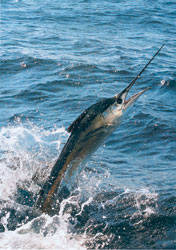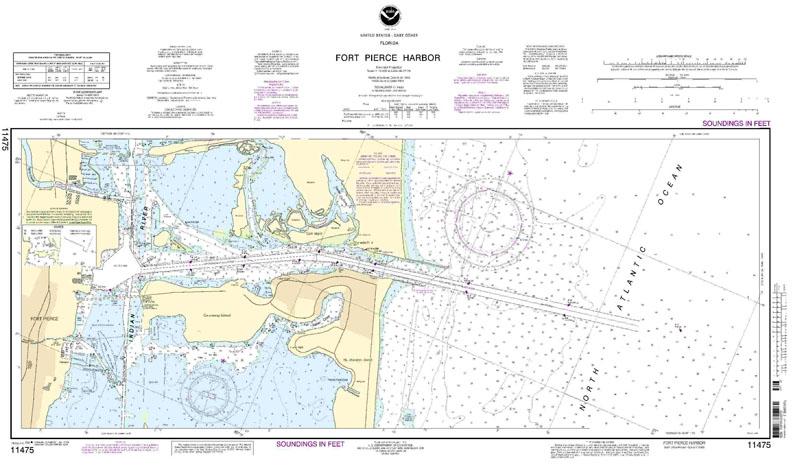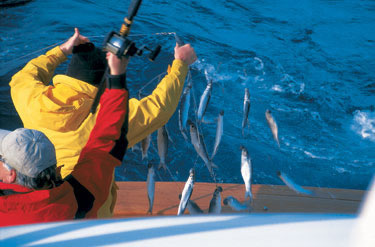October 27, 2014
By Florida Sportsman Staff
High-leaping Atlantic sails gather at the northern end of Sailfish Alley in early winter.

High-leaping Atlantic sails gather at the northern end of Sailfish Alley in early winter. |
A walk down Fort Pierce docks reads like a Who's Who list of sailfish chasers. You'll see boats, and crews, from all over the state—Jax, St. Augustine, St. Pete, Tampa, Daytona Beach, Panama City—plus a few from other locales that voyaged long distances to berth here.
What's more, every tale you've read in our pages in previous issues comes true when cool northerly winds push the main body of fish past the Cape and into town. Best yet, it's all available for Florida trailer boaters within short striking distance daily—if you time it right, say November through early January.
Timing involves playing the cold fronts to your advantage. Rough seas and high winds mean little when you're dragging baits behind a 50- or 60-footer. Head out in the average mid-20-foot center console and winter conditions take on new meaning. Not many of us care to rock and roll in chilly seas for fun. Planning your trips for calm days between fronts is the way to go. Chances are you'll release plenty of sails without enduring any hardships.
Release Grounds
 Fort Pierce, at the north end of Sailfish Alley, heats up when temperatures drop.
Fort Pierce, at the north end of Sailfish Alley, heats up when temperatures drop.
Billfish top the chart, on land and sea.
Finding hot sailfish waters takes a keen eye and attention to details. A series of reefs shadows the coastline in about 65 feet of water southeast of Fort Pierce Inlet. The coral heads attract bait and predators, particularly sailfish. Frequently, though, by late November water temps at the 65-foot depths run too chilly for sailfish comfort—once repeated fronts roll into town. When the temperature gauge dips into the low 70s, head out a little farther to the reefline between 120 and 150 feet of water. That's where you'll find the largest concentration of sails and bait.
Many days, an edge forms near the 120-foot reef (locals call it the 8-Mile), due to its proximity to the Gulf Stream. In winter, warm spinoffs from the Stream bring bait pods and sails closer to shore, so it pays to really watch the bottom machine for pods suspended in the water column. After locating these bait balls, stick close to them—especially if you mark larger, boomerang-shaped fish above, below or patrolling the outskirts of the bait pod. There's a good probability that the fish you're marking are sails, and in case you're not familiar with spindlebeak ways, sails rarely travel alone. They're more of a “pack” fish that hunt prey in small groups.
Natural bottom structures attract sailfish and so do the not-so-natural ones, such as artificial reefs and wrecks. Wrecks, by the way, can be very productive for sailfishers. The best seem to be smaller ones such as sunken boats or culverts with pronounced vertical relief resting on bottom in 100 to 200 feet of water. Florida Sportsman Fishing Chart No. 6, Fort Pierce/Stuart shows several excellent sailfish wrecks and reefs along with the layout of the land and reef contours off the coastline. As a general rule, good sailfish waters are about a 10- to 15-mile run from the inlet.
Sails sometimes reveal their whereabouts by surface activity. A north swell with northwest winds often prods sails to “tail” or surf downsea. Many times this occurs just shoreward of the western edge of the northerly flowing Gulf Stream, out of the hard-running current. It takes a trained eye to spot a sickle tail slicing down the face of a swell, but once you get dialed in, seeing tailers increases your chances of hookups significantly. Proven approaches for intercepting tailers include dragging a bait spread in front of a fish's bill or tossing a pitchbait to fish.
Tricks of the Trade
Fort Pierce anglers traditionally troll rigged ballyhoo for sails. Some have elevated the practice to almost an art form, with intricate details for tournament fishing.
Jumping a few fish doesn't have to be hard or involve hours of professional bait and teaser rigging. Family fishers can employ similar strategies that provoke hookups without the extra toil. You will need to master the basics, however, such as rigging ballyhoo and deploying a dredge teaser, an umbrella-shaped frame with multiple natural or plastic baits in tow that resembles a bait pod.
We've covered suitable ballyhoo rigs and dredges in past issues, but here's a quick refresher. Small ballyhoo, often referred to as “dinks” by veteran sailfishers, are by far the best size for hooking an Atlantic sail, due to the fish's relatively small mouth and the species' tendency to bat baits before swallowing. Dredge teasers draw sails, period. Nothing raises a sail into a ballyhoo spread like a dredge. No need to spend all night rigging silver mullet and ballyhoo to string on the dredge, not with all the pre-rigged plastic ballyhoo and shad-tail models on the market. Shop around and purchase a dredge that's compatible with your boat's setup. (I keep a double-tier model manufactured by Calcutta Baits rigged and ready with plastic shad for deployment off a stern cleat; it seems to draw fish without fail.)
On the Map
Fort Pierce is located in Southeast Florida, about 30 miles as the crow flies below Sebastian and 20 miles north of Stuart. The town is rebuilding since hurricanes Frances and Jeanne almost whipped it into submission last fall. Hotels and motels are adding rooms daily, but the best news is that all boat ramps are up and running.
Billfishermen traveling to or trailering boats to Fort Pierce can take Interstate 95 to one of the several well-marked exits that lead straight into town. Gulf Coast anglers shoot across the state on S.R. 70, which runs between Sarasota and Fort Pierce or S.R. 60, that intersects Tampa with Vero Beach (a short hop north of Fort Pierce.
Click
www.visitstluciefla.com or enter Fort Pierce into any Web search machine for a list of available accommodations, other recreational opportunities and upcoming events.
Standard gear for sailfishing here is 20-pound tackle, either conventional or spin. Conventional reels, such as a Shimano TLD 20, Penn Graphite-Lite 20, Okuma Titus Gold 20 or Pflueger 20GL, that holds 400 yards or more of line gets the lion's share of duties. If you prefer to battle sails with spin tackle, choose a reel with the Bait Runner, Live-Liner or Freeliner feature. You'll need it for dropping back baits (more on this later) to fish. Reels in this class include the Tidewater 60FLX, Shimano BTR 6500B and Penn Slammer/Live Liner 560.
Dropback City

Natural dredge teasers summon sails to trolling spreads. |
Hooking a sail on trolled baits is different than livebait fishing. Reel control is key in this release game. Atlantic sailfish seldom charge a trolled ballyhoo and inhale it on the first go-round. They bat it first, the same way they do with wild prey. This slashing bill attack usually pops the flatline and outrigger clips, alerting anglers there's a fish in the spread.
Hooking that fish is up to you. Savvy trollers and tournament fishers throw the reel into freespool, dumping yards of line to the fish so it won't “feel” the hook or any pressure from the line. How long to drop back is a matter of personal preference, but don't do it for too long—the sail will spit the hook. Most sailfishers stick with a 5-count dropback, then shove the reel into gear. If the fish feels the hook, you'll see the results immediately as the fish goes ballistic with tailwalks, jumps and drag-burning runs.
Natural dredge teasers summon sails to trolling spreads.
Fort Pierce fish are calling. Are you ready for some fun?
FS
First Published Florida Sportsman November 2005
By Frank Bolin

